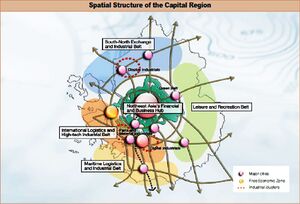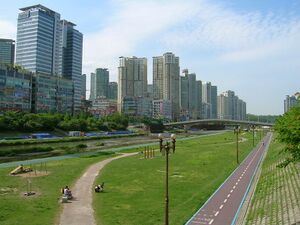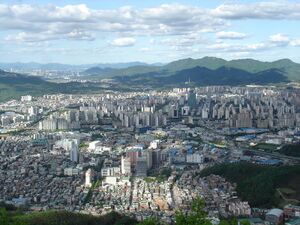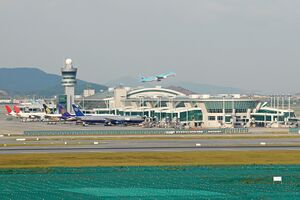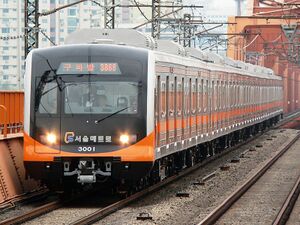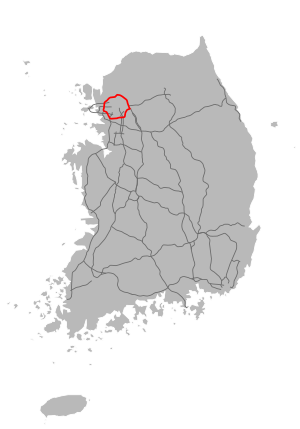منطقة العاصمة سول
Seoul Metropolitan Area
수도권 | |
|---|---|
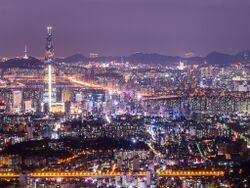 Seoul, the largest city in the metropolitan area | |
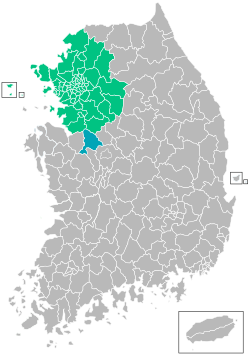 | |
| Country | South Korea
|
| Major cities | Seoul Incheon Suwon Ansan Anyang Goyang Seongnam Bucheon Yongin |
| المساحة | |
| • Capital area | 12٬685 كم² (4٬898 ميل²) |
| التعداد (2020) | |
| • العمرانية | 26٬037٬000[1] |
| • الكثافة العمرانية | 2٬053/km2 (5٬320/sq mi) |
| • Percentage of South Korea's total population | ~55% (51 million) |
| GDP | |
| • Metro | KR₩1,137 trillion US$909.6 billion (2022) |
| HDI (2021) | 0.952[3] very high · 1st |
| منطقة العاصمة سول | |
| هانگول | 수도권 |
|---|---|
| هانچا | 首都圈 |
| الرومنة المعدلة | Sudogwon |
| مكيون-رايشاور | Sudokwŏn |
| Gyeonggi Region | |
| هانگول | 경기 지방 |
| هانچا | 京畿地方 |
| الرومنة المعدلة | Gyeonggi jibang |
| مكيون-رايشاور | Kyŏnggi chibang |
The Seoul Metropolitan Area (Sudogwon; الكورية: 수도권, [sʰu.do.k͈wʌ̹n]) or Gyeonggi region (경기 지방), is the metropolitan area of Seoul, Incheon, and Gyeonggi Province, located in north-west South Korea. Its population of 26 million (as of 2024)[1] is ranked as the fourth largest metropolitan area in the world. Its area is about 12,685 km2 (4,898 sq mi). It forms the cultural, commercial, financial, industrial, and residential center of South Korea. The largest city is Seoul, with a population of approximately 10 million people, followed by Incheon, with 3 million inhabitants.
. . . . . . . . . . . . . . . . . . . . . . . . . . . . . . . . . . . . . . . . . . . . . . . . . . . . . . . . . . . . . . . . . . . . . . . . . . . . . . . . . . . . . . . . . . . . . . . . . . . . . . . . . . . . . . . . . . . . . . . . . . . . . . . . . . . . . . . . . . . . . . . . . . . . . . . . . . . . . . . . . . . . . . . .
Geography and climate
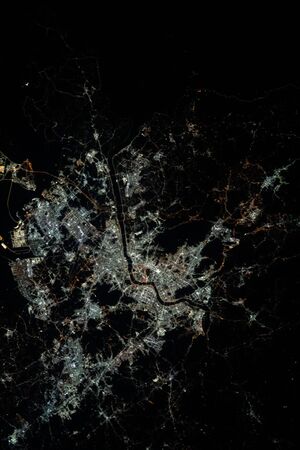
The Capital Area occupies a plain in the Han River valley.[4]
History
Demographics
Covering only about 12% of the country's area, the Seoul Metropolitan Area is home to more than 48.2% of the national population, and is the world's ninth largest urban area. This percentage has risen steadily since the mid-20th century, and the trend is expected to continue. Currently more than half of the people who move from one region to another are moving to the capital area.[2] In 2020, it was reported that the Seoul Metropolitan Area's population had exceeded 50% of the country's total population, with 25,925,799 people living in the area (50.002% of the total 51,849,861).[5]
الاقتصاد
| Subdivision | Area km2 | Population | GDP (KR₩)[2] | GDP (US$)[6] |
|---|---|---|---|---|
| 10,184 | 13,511,676 | ₩ 547 trillion | US$ 437.6 billion | |
| 605 | 9,586,195 | ₩ 486 trillion | US$ 388.8 billion | |
| 1,063 | 2,945,454 | ₩ 104 trillion | US$ 83.2 billion | |
| Seoul Metropolitan Area | 11,852 | 26,043,325 | ₩ 1,137 trillion | US$ 909.6 billion |
In 2020, Seoul Metropolitan Area's Gross Regional Product was around US$900 billion, generating around half of the country's total GDP.[2] It is the fourth largest urban economy in the world after Tokyo, New York and Los Angeles but ahead of Paris and London.[7] The region hosts headquarters of 59 Forbes Global 2000 companies.[8] As the economy of Seoul Metropolitan Area transformed to knowledge economy from the manufacturing-based economy of the 20th century, there are a number of high-tech business parks in Seoul Metropolitan Area, such as Digital Media City and Pangyo Techno Valley.[بحاجة لمصدر]
The Seoul Metropolitan Area is home to the most affluent and livable cities and apartments in Korea but there are significant discrepancies between cities and districts, particularly between those built in the older and newer generations. Newer areas with more modern and luxurious apartments and infrastructure are more expensive, along with proximity to Gangnam District, the commercial center of the region.[9]
Government
Various agencies have been set up to deal with the intergovernmental problems of the region. Proposals for consolidating some or all of the cities of the capital area into a handful of metropolitan cities have thus far not been implemented.[بحاجة لمصدر]
Development in the area is currently governed by the Capital Region Readjustment Planning Act (수도권정비계획법), first passed in 1982 and last revised in 1996.[بحاجة لمصدر]
التقسيمات
The Seoul Metropolitan Area is divided among the special city of Seoul, the metropolitan city of Incheon, and province of Gyeonggi. Seoul has 25 gu (local government wards),[10] Incheon has 8 gu and 2 counties, and Gyeonggi Province has 28 cities and 3 counties as the subdivisions.
سول
The 25 districts of Seoul.
- Dobong District (도봉구; 道峰區)
- Dongdaemun District (동대문구; 東大門區)
- Dongjak District (동작구; 銅雀區)
- Eunpyeong District (은평구; 恩平區)
- Gangbuk District (강북구; 江北區)
- Gangdong District (강동구; 江東區)
- Gangnam District (강남구; 江南區)
- Gangseo District (강서구; 江西區)
- Geumcheon District (금천구; 衿川區)
- Guro District (구로구; 九老區)
- Gwanak District (관악구; 冠岳區)
- Gwangjin District (광진구; 廣津區)
- Jongno District (종로구; 鍾路區)
- Jung District (중구; 中區)
- Jungnang District (중랑구; 中浪區)
- Mapo District (마포구; 麻浦區)
- Nowon District (노원구; 蘆原區)
- Seocho District (서초구; 瑞草區)
- Seodaemun District (서대문구; 西大門區)
- Seongbuk District (성북구; 城北區)
- Seongdong District (성동구; 城東區)
- Songpa District (송파구; 松坡區)
- Yangcheon District (양천구; 陽川區)
- Yeongdeungpo District (영등포구; 永登浦區)
- Yongsan District (용산구; 龍山區)
. . . . . . . . . . . . . . . . . . . . . . . . . . . . . . . . . . . . . . . . . . . . . . . . . . . . . . . . . . . . . . . . . . . . . . . . . . . . . . . . . . . . . . . . . . . . . . . . . . . . . . . . . . . . . . . . . . . . . . . . . . . . . . . . . . . . . . . . . . . . . . . . . . . . . . . . . . . . . . . . . . . . . . . .
إنچن
The 8 districts and 2 counties of Incheon.
|
|
Gyeonggi-do
28 cities and 3 counties of Gyeonggi-do. Below are seven of the largest cities, sorted by their population size:
Suwon
The 4 gu of Suwon (수원; 水原).
- Paldal-gu (팔달구; 八達區)
- Yeongtong-gu (영통구; 霊通區)
- Jangan-gu (장안구; 長安區)
- Gwonseon-gu (권선구; 勸善區)
Goyang
The 3 gu of Goyang (고양; 高陽).
- Deogyang-gu (덕양구; 德陽區)
- Ilsandong-gu (일산동구; 一山東區)
- Ilsanseo-gu (일산서구; 一山西區)
Yongin
The 3 gu of Yongin (용인; 龍仁).
- Cheoin-gu (처인구; 處仁區)
- Giheung-gu (기흥구; 器興區)
- Suji-gu (수지구; 水枝區)
Seongnam
The 3 gu of Seongnam (성남; 城南).
- Bundang-gu (분당구; 盆唐區)
- Jungwon-gu (중원구; 中原區)
- Sujeong-gu (수정구; 壽井區)
Bucheon
Ansan
The 2 gu of Ansan (안산; 安山).
- Danwon-gu (단원구; 檀園區)
- Sangnok-gu (상록구; 常綠區)
Anyang
The 2 gu of Anyang (안양; 安養).
|
. . . . . . . . . . . . . . . . . . . . . . . . . . . . . . . . . . . . . . . . . . . . . . . . . . . . . . . . . . . . . . . . . . . . . . . . . . . . . . . . . . . . . . . . . . . . . . . . . . . . . . . . . . . . . . . . . . . . . . . . . . . . . . . . . . . . . . . . . . . . . . . . . . . . . . . . . . . . . . . . . . . . . . . .
Transportation
The cities of the capital area are tightly interconnected by road and rail. Many of the country's railroad lines, most notably the Gyeongbu Line, terminate in the region. In addition, rapid transit is provided by the Seoul Metropolitan Subway, which has lines that serve all districts of Seoul, as well as the city of Incheon and other surrounding cities within Gyeonggi Province.[11][12]
The region is a nexus for travel by air and water. The country's two largest airports, Incheon International Airport and Gimpo International Airport, are in the metropolitan area.[11] International and domestic ferries depart from Incheon's ferry terminals several times a day.[13]
Seoul Ring Expressway (Expressway No. 100) connects satellite cities around Seoul.[14]
See also
- Geography of South Korea
- Regions of Korea
- Demographics of South Korea
- Capital Region
- List of metropolitan areas by population
- List of metropolitan areas in Asia by population
- Subdivisions of South Korea
- Seoul Ring Expressway
- Greater Tokyo Area
- Jing-Jin-Ji
- Hanoi Capital Region
Notes
- ^ http://kostat.go.kr/portal/korea/kor_nw/1/13/2/index.board?bmode=read&bSeq=&aSeq=379534&pageNo=1&rowNum=10&navCount=10&currPg=&searchInfo=&sTarget=title&sTxt=%7Ctitle=2018년 지역소득(잠정).
- ^ أ ب ت "2022년 지역소득(잠정)". www.kostat.go.kr.
- ^ "Sub-national HDI - Area Database - Global Data Lab". hdi.globaldatalab.org (in الإنجليزية). Retrieved 2018-09-13.
- ^ Chase, David (1960). "A Limited Archæological Survey of the Han River Valley in Central Korea". Asian Perspectives. 4 (1/2): 141–149. ISSN 0066-8435. JSTOR 42927497.
- ^ "Greater Seoul population exceeds 50% of S. Korea for first time". english.hani.co.kr. Retrieved 2023-08-20.
- ^ "South Korean Won to US Dollar Spot Exchange Rates for 2022". www.exchangerates.org.uk.
- ^ "Global Wealth GDP Nominal Distribution: Who Are The Leaders Of The Global Economy? - Full Size". www.visualcapitalist.com. Retrieved 2022-03-27.
- ^ "The World's Largest Public Companies". Forbes.
- ^ "미군 잔류로 낙후된 동두천, 특별법 제정해야". www.yonhapnews.co.kr. 2014-12-23.
- ^ "The Statistic of Seoul". Seoul Solution. 2023. Retrieved 2023-08-20.
- ^ أ ب "Getting around Seoul is easy for first-timers with these simple tips". Lonely Planet (in الإنجليزية). Retrieved 2023-08-20.
- ^ "Seoul public transportation - Seoul metro maps |". Official Website of the (in الإنجليزية الأمريكية). Retrieved 2023-08-20.
- ^ "Incheon Port International Passenger Terminal". www.icferry.or.kr. Retrieved 2023-08-20.
- ^ "First DoubleTree by Hilton Hotel coming to Korea". koreatimes (in الإنجليزية). 2018-07-05. Retrieved 2023-08-20.
- ^ Korea National Statistical Office (2008-07-22). e나라지표:수도권 인구 집중 현황 (in الكورية).
- ^ Ryu Boseon (류보선) (2005-08-23). 수도권 인구 편중현상 계속 (in الكورية). Korea National Statistical Office (KNSO) News. Archived from the original on 2007-09-28.
- ^ Hong, Yong-deok (홍용덕) (2005-06-01). 각종 분산정책 불구하고 수도권은 ‘인구 블랙홀’ (in الكورية). The Hankyoreh.
وصلات خارجية
- Official website of Seoul Metropolitan government
- Metropolitan Air Quality Management Office, in Korean
- Capital Region Development Institute, in Korean
- Chosun Ilbo metro news, in Korean Archived 2014-10-12 at the Wayback Machine
- [3]
- CS1 الإنجليزية الأمريكية-language sources (en-us)
- Articles with hatnote templates targeting a nonexistent page
- Missing redirects
- Short description is different from Wikidata
- Articles containing كورية-language text
- Articles containing Korean-language text
- Pages using infobox settlement with no coordinates
- مقالات ذات عبارات بحاجة لمصادر
- CS1 uses الكورية-language script (ko)
- CS1 الكورية-language sources (ko)
- South Korea articles missing geocoordinate data
- All articles needing coordinates
- منطقة العاصمة سول
